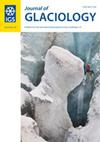Controls on calving at a large Greenland tidewater glacier: stress regime, self-organised criticality and the crevasse-depth calving law
IF 2.6
3区 地球科学
Q2 GEOGRAPHY, PHYSICAL
引用次数: 0
Abstract
We investigate the physical basis of the crevasse-depth (CD) calving law by analysing relationships between glaciological stresses and calving behaviour at Sermeq Kujalleq (Store Glacier), Greenland. Our observations and model simulations show that the glacier has a stable position defined by a compressive arch between lateral pinning points. Ice advance beyond the arch results in calving back to the stable position; conversely, if melt-undercutting forces the ice front behind the stable position, it readvances because ice velocities exceed subaqueous melt rates. This behaviour is typical of self-organising criticality, in which the stable ice-front position acts as an attractor between unstable super-critical and sub-critical regimes. This perspective provides strong support for a ‘position-law’ approach to modelling calving at Sermeq Kujalleq, because any calving ‘rate’ is simply a by-product of how quickly ice is delivered to the critical point. The CD calving law predicts ice-front position from the penetration of surface and basal crevasse fields, and accurately simulates super-critical calving back to the compressive arch and melt-driven calving into the sub-critical zone. The CD calving law reflects the glaciological controls on calving at Sermeq Kujalleq and exhibits considerable skill in simulating its mean position and seasonal fluctuations.格陵兰大潮汐冰川崩解的控制:应力状态、自组织临界和裂缝深度崩解规律
通过分析格陵兰Sermeq Kujalleq (Store Glacier)冰川应力与冰裂行为之间的关系,研究了冰裂深度(CD)冰裂规律的物理基础。我们的观测和模型模拟表明,冰川有一个稳定的位置,由侧向固定点之间的压缩拱确定。冰向拱外推进导致冰崩回稳定位置;相反,如果融冰削弱迫使冰锋在稳定位置的后面,它就会前进,因为冰的速度超过了水下的融化速度。这种行为是典型的自组织临界,其中稳定的冰锋位置在不稳定的超临界和亚临界状态之间起着吸引作用。这一观点有力地支持了用“位置定律”方法来模拟Sermeq Kujalleq冰川的冰裂,因为任何冰裂的“速率”都只是冰被输送到临界点的速度的副产品。CD裂陷规律通过地表和基底裂陷场的贯通预测冰锋位置,准确模拟了超临界裂陷回压缩拱和熔体驱动裂陷进入亚临界区。CD产犊规律反映了Sermeq Kujalleq冰川对产犊的控制,在模拟其平均位置和季节波动方面表现出相当大的技巧。
本文章由计算机程序翻译,如有差异,请以英文原文为准。
求助全文
约1分钟内获得全文
求助全文
来源期刊

Journal of Glaciology
地学-地球科学综合
CiteScore
5.80
自引率
14.70%
发文量
101
审稿时长
6 months
期刊介绍:
Journal of Glaciology publishes original scientific articles and letters in any aspect of glaciology- the study of ice. Studies of natural, artificial, and extraterrestrial ice and snow, as well as interactions between ice, snow and the atmospheric, oceanic and subglacial environment are all eligible. They may be based on field work, remote sensing, laboratory investigations, theoretical analysis or numerical modelling, or may report on newly developed glaciological instruments. Subjects covered recently in the Journal have included palaeoclimatology and the chemistry of the atmosphere as revealed in ice cores; theoretical and applied physics and chemistry of ice; the dynamics of glaciers and ice sheets, and changes in their extent and mass under climatic forcing; glacier energy balances at all scales; glacial landforms, and glaciers as geomorphic agents; snow science in all its aspects; ice as a host for surface and subglacial ecosystems; sea ice, icebergs and lake ice; and avalanche dynamics and other glacial hazards to human activity. Studies of permafrost and of ice in the Earth’s atmosphere are also within the domain of the Journal, as are interdisciplinary applications to engineering, biological, and social sciences, and studies in the history of glaciology.
 求助内容:
求助内容: 应助结果提醒方式:
应助结果提醒方式:


